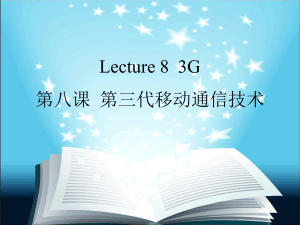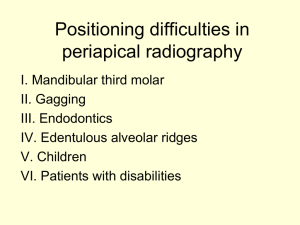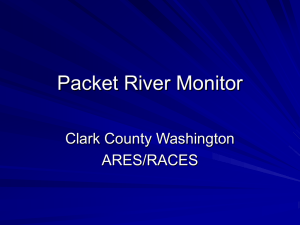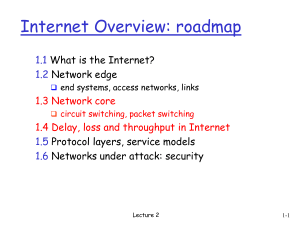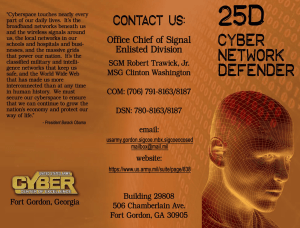Communication Networks
advertisement
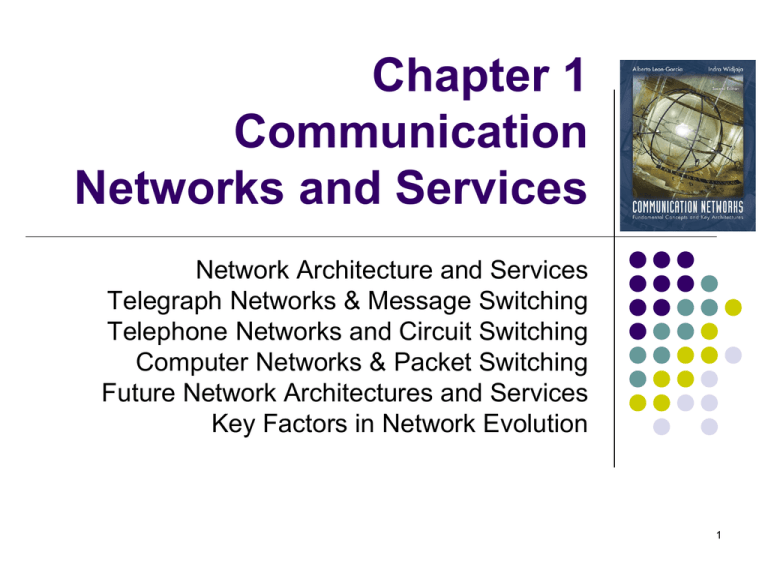
Chapter 1 Communication Networks and Services Network Architecture and Services Telegraph Networks & Message Switching Telephone Networks and Circuit Switching Computer Networks & Packet Switching Future Network Architectures and Services Key Factors in Network Evolution 1 A communication network, in its simplest form, is a set of equipment (機器) and facilities (管線) that provides services: the transfer of information between users located at various geographical points. Examples are such as telephone network, computer network, television broadcasting network, cellular networks, and Internet. The modern communication networks have the ability to transfer communication at extremely high speeds, which allows users to gather information in large volume nearly instantaneously and, with the aid of computers, to almost immediately exercise action at a distance. 2 Chapter 1 Communication Networks and Services 1.1 Evolution of Network Architecture and Services 3 Telegraph/Telephone Networks and Services A telegraph/telephone network enables the exchange of information between users at different locations. It provides telegraph/telephone services. Telegraph/Telephone Real-time bidirectional voice exchange 4 Computer Networks and Services A computer networks enable the exchange of information between users at different locations. It provides E-mail, web browsing services,… E-mail, Web browsing E-mail server Exchange of text messages via servers 5 Cellular Networks and Services A cellular networks enable the exchange of information between users at different locations. It supports mobile services. Voice/Data/Video Real-time voice exchange with mobile users 6 Many other examples Peer-to-peer applications Napster, Gnutella, Kazaa file exchange Audio & video streaming Network games On-line purchasing Text messaging in PDAs, cell phones (SMS) Voice-over-Internet 7 What is a communication network? Communication Network The communication network is composed of equipments (hardware & software) and facilities that provide the basic communication service Equipment Routers, servers, switches, multiplexers, hubs, modems, … Facilities Copper wires, coaxial cables, optical fiber Ducts, conduits, telephone poles … 8 How are communication networks designed and operated? Communication Network Architecture Network architecture: the plan that specifies how the network is built and operated Architecture is driven by the network services Overall communication process is complex Network architecture partitions overall communication process into separate functional areas called layers Next we will trace evolution of three network architectures: telegraph, telephone, and computer networks 9 Network Architecture Evolution Telegraph Networks Telephone Networks Circuit Switching Analog transmission → digital transmission Mobile communications Computer Networks and Internet Message switching & digital transmission Packet switching & computer applications Next-Generation Internet Multiservice packet switching network 10 Chapter 1 Communication Networks and Services 1.1.1 Telegraph Networks & Message Switching 11 Telegraphs & Long-Distance Communications Approaches to long-distance communications Courier(信使): physical transport of the message Telegraph(電報): message is transmitted across a network using electrical signals Messenger pigeons, pony express, FedEx Drums, beacons, mirrors, smoke, flags, semaphores, light, … Telegraph delivers message much sooner 12 Optical (Visual) Telegraph Claude Chappe invented optical telegraph in the 1790’s Semaphore mimicked a person with outstretched arms with flags in each hand Different angle combinations of arms & hands generated hundreds of possible signals Code for enciphering messages kept secret Signal could propagate 800 km in 3 minutes! 13 Message Switching Network nodes were created where several optical telegraph lines met (Paris and other sites) Store-and-Forward Operation: Messages arriving on each line were decoded Next-hop in route determined by destination address of a message Each message was carried by hand to next line, and stored until operator became available for next transmission Network Node North line West line East line South line 14 Electric Telegraph William Sturgeon Electro-magnet (1825) Joseph Henry (1830) Current over 1 mile of wire to ring a bell Samuel Morse (1835) Electric current in a wire wrapped around a piece of iron generates a magnetic force Pulses of current deflect electromagnet to generate dots & dashes Experimental telegraph line over 40 miles (1840) Signal propagates at the speed of light!!! Approximately 2 x 108 meters/second in cable 15 Digital Communications Morse code converts text message into sequence of dots and dashes Use transmission system designed to convey dots and dashes Morse Code Morse Code Morse Code Morse Code A · — J ·——— S ··· 2 ··——— B —··· K —·— T — 3 ···—— C —·—· L ·—·· U ··— 4 ····— D —·· M —— V ···— 5 ····· E · N —· W ·—— 6 —···· F ··—· O ——— X —··— 7 ——··· G ——· P ·——· Y —·—— 8 ———·· H ···· Q ——·— Z ——·· 9 ————· I ·· R ·—· 1 ·———— 0 ————— 16 Electric Telegraph Networks Electric telegraph networks exploded Message switching & Store-and-Forward operation Key elements: Addressing, Routing, Forwarding Optical telegraph networks disappeared Message Message Message Source Message Switches Destination 17 Baudot Telegraph Multiplexer Operator 25-30 words/minute but a wire can carry much more Baudot multiplexer: Combine 4 signals in 1 wire Binary block code (ancestor of ASCII code) A character represented by 5 bits Time division multiplexing Binary codes for characters are interleaved Framing is required to recover characters from the binary sequence in the multiplexed signal Keyboard converts characters to bits 18 Baudot Telegraph Multiplexer Keyboard Baudot Multiplexer Baudot Demultiplexer Paper Tape Printer Paper Tape Printer …A2D1C1B1A1 5 bits / character Paper Tape Printer Paper Tape Printer 19 Elements of Telegraph Network Architecture Digital transmission Multiplexing Text messages converted into symbols (dots/dashes, Baudot/ASCII codes) Transmission system designed to convey symbols Framing needed to recover text characters Message Switching Messages contain source & destination addresses Store-and-Forward: Messages forwarded hop-by-hop across network Routing according to destination address 20 Chapter 1 Communication Networks and Services 1.1.2 Telephone Networks and Circuit Switching 21 Bell’s Telephone Alexander Graham Bell (1875) working on harmonic telegraph to multiplex telegraph signals Discovered voice signals can be transmitted directly Microphone converts voice pressure variation (sound) into analogous electrical signal Loudspeaker converts electrical signal back into sound Telephone patent granted in 1876 Bell Telephone Company founded in 1877 Signal for “ae” as in cat Microphone sound Loudspeaker analog electrical signal sound 22 Signaling Signaling required to establish a call Flashing light and ringing devices to alert the called party of incoming call Called party information to operator to establish calls Signaling + voice signal transfer 23 The Connection N2 Problem For N users to be fully connected directly Requires N(N – 1)/2 connections Requires too much space for cables Inefficient & costly since connections not always on 1 N = 1000 N(N – 1)/2 = 499500 2 N 4 3 24 Circuit Switching Patchcord panel switch invented in 1877 Operators connect users on demand Establish circuit to allow electrical current to flow from inlet to outlet for the whole conversation Only N connections required to central office 1 N N–1 3 2 25 Manual Switching 26 Strowger Switch Human operators intelligent & flexible But expensive and not always discreet Strowger invented automated switch in 1888 Each current pulse advances wiper by 1 position User dialing controls connection setup Decimal telephone numbering system Hierarchical network structure simplifies routing Area code, office (CO) code, station number 1st digit 2nd digit ... 0 0 0 . . . . . . . . . 9 0 9 9 9 27 Strowger Switch - Electromechanical Switch 28 Hierarchical Network Structure Toll CO = central office Tandem Tandem CO CO CO CO CO Telephone subscribers connected to local CO (central office) Tandem & Toll switches connect CO’s 29 Three Phases of a Connection 1. 2. Telephone network Pick up phone Dial tone. Telephone network Connection set up Dial number 3. Telephone network Network selects route; 4. Telephone network Sets up connection; Called party alerted Information transfer Connection release 5. Telephone network 6. Telephone network Exchange voice signals Hang up. 30 Computer Connection Control Coordinate set up of telephone connections To implement new services such as caller ID, voice mail, . . . To enable mobility and roaming in cellular networks “Intelligence” inside the network A signaling network is required (Signaling System 7) Computer Signaling Switch connects Inlets to Outlets ... A computer controls connection in telephone switch Computers exchange signaling messages to: ... Voice 31 Digitization of Telephone Network Pulse Code Modulation digital voice signal Time Division Multiplexing for digital voice T-1 multiplexing (1961): 24 voice signals = 1.544x106 bps Digital Switching (1980s) Voice gives 8 bits/sample x 8000 samples/sec = 64x103 bps Switch TDM signals without conversion to analog form Digital Cellular Telephony (1990s) Optical Digital Transmission (1990s) One OC-192 optical signal = 10x109 bps One optical fiber carries 160 OC-192 signals = 1.6x1012 bps! All digital transmission, switching, and control 32 Digital Transmission Evolution Wavelength Division Multiplexing Information transfer per second 1.0E+14 ? 1.0E+12 1.0E+10 1.0E+08 T-1 Carrier 1.0E+06 1.0E+04 SONET Optical Carrier Baudot 1.0E+02 1.0E+00 1850 1875 1900 1925 1950 1975 2000 Morse 33 Essential Elements of Telephone Network Architecture Digital transmission & switching Circuit switching User signals for call setup and tear-down Route selected during connection setup End-to-end connection across network Signaling coordinates connection setup/tear down Hierarchical Network Digital voice; Time Division Multiplexing Decimal numbering system Hierarchical structure; simplified routing; scalability Signaling Network Intelligence inside the network 34 IEET 工程認證 (Engineering Accreditation) October 8 EF (二)(北科大) → October 9 GH (三) October 15 EF (成大) → October 16 GH December 17 EF (清大) → December 18 GH November 20 (Wed) GH: MidTerm Exam January 7 (Tue) EF: Final Exam Sorry for the adjustment! 35 Chapter 1 Communication Networks and Services 1.1.3 The Internet, Computer Networks, and Packet Switching 36 Computer Network Evolution Overview 1950s: Telegraph technology adapted to computers 1960s: Dumb terminals access shared host computer SABRE airline reservation system 1970s: Computers connect directly to each other ARPANET packet switching network TCP/IP internet protocols Ethernet local area network 1980s & 1990s: New applications and Internet growth Commercialization of Internet E-mail, file transfer, web, P2P, . . . Internet traffic surpasses voice traffic 37 What is a protocol? (p.10) Communications between computers requires very specific unambiguous rules A protocol is a set of rules that governs how two or more communicating parties (entities) are to interact HyperText Transfer Protocol (HTTP) File Transfer Protocol (FTP) Simple Mail Transfer Protocol (SMTP) Internet Protocol (IP) Domain Name System (DNS) Transmission Control Protocol (TCP) 38 (411) Directory Assistance查號服務 Caller Dials 411 “What city”? Caller replies “Springfield” “What name?” Caller replies Caller replies Caller waits System replies “Simpson” “Thank you, please hold” Caller waits System replies “Do you have a first name or street?” “Evergreen Terrace” “Thank you, please hold” System replies Operator replies Operator replies System replies with number Caller dials 411 Directory Assistance 號服務 Fig. 1.6 411 Protocol:Typical Message Exchange when requesting a telephone number 39 A. TERMINAL-ORIENTED NETWORKS Early computer systems very expensive Time-sharing methods allowed multiple terminals to share local computer Remote access via telephone modems Terminal ... Terminal Host computer Modem pool Telephone Network Fig. 1.7 Terminal-oriented network Modem Terminal 40 Medium Access Control Dedicated communication lines in Fig. 1.7 are expensive and inefficient since terminals generate messages sporadically Frames carried messages to/from attached terminals Address in frame header identified terminal Medium Access Controls for sharing a line were developed Example: Polling protocol on a multidrop line Host computer Polling frames & output frames Response & input frames Terminal Fig. 1.8 Multidrop Configuration Terminal ... Terminal Terminals at different locations in a city Must avoid collisions on inbound line 41 Statistical Multiplexing Statistical multiplexer allows a line to carry frames that contain messages to/from multiple terminals Frames are buffered at multiplexer until line becomes available, i.e. store-and-forward Address in frame Header identifies terminal Header carries other control information Frame CRC Information Terminal Header Header Information ... Terminal CRC Terminal Host computer Multiplexer 42 Error Control Protocol Communication lines introduced errors Error checking codes used on frames “Cyclic Redundancy Check” (CRC) calculated based on frame header and information payload, and appended Header also carries ACK/NAK control information Retransmission requested when errors detected Automatic Repeat Request (ARQ) CRC Information Header Terminal Header Information CRC 43 Tree Topology Networks In contrast to multidrop (bus) topology, there is a tree topology network Tree Networks are usually adopted by National & international terminal-oriented networks Routing was very simple (to/from host) Each network typically handled a single application Fig. 1.10 Typical Terminal-oriented Network circa 1970 multidrop San Francis co T T Chicago T Atlanta New York City 44 B. COMPUTER-TO-COMPUTER NETWORKS As cost of computing dropped, terminal-oriented networks viewed as too inflexible and costly Need to develop flexible computer networks Interconnect computers as required, usually mesh network Support many applications Application Examples File transfer between arbitrary computers Execution of a program on another computer Multiprocess operation over multiple computers 45 Packet Switching Network should support multiple applications Packet switching introduced Transfer arbitrary message size Low delay for interactive applications But in store-and-forward operation, long messages induce high delay on interactive messages Network transfers packets using store-and-forward Packets have maximum length Break long messages into multiple packets ARPANET testbed led to many innovations 46 ARPANET Packet Switching Host generates message Source packet switch converts message to packet(s) Packets transferred independently across network Destination packet switch reasembles message Destination packet switch delivers message Packet Switch Message Packet 2 Packet Switch Packet 1 Packet 2 Message Packet Switch Packet Packet 1 Packet Switch Packet 1 Switch 47 ARPANET Routing Routing is highly nontrivial in mesh networks No connection setup prior to packet transmission Packets header includes source & destination addresses Packet switches have table with next hop per destination Routing tables calculated by packet switches using distributed algorithm Packet Switch Hdr Packet Packet Switch Packet Switch Dest: Next Hop: Packet Switch Packet Switch xyz abc wvr edf 48 Other ARPANET Protocols Error control between adjacent packet switches Congestion control between source & destination packet switches limit number of packets in transit Flow control between host computers prevents buffer overflow Packet Switch Packet Switch Error Control Congestion Control Packet Switch Packet Switch Packet Switch Flow Control 49 ARPANET Applications ARPANET introduced many new applications Email, remote login, file transfer, … Intelligence at the edge AMES McCLELLAN UTAH BOULDER GWC CASE RADC ILL CARN LINC USC AMES MIT MITRE UCSB STAN SCD ETAC UCLA RAND TINKER BBN HARV NBS 50 Ethernet Local Area Network (LAN) In 1980s, affordable workstations available Need for low-cost, high-speed networks To interconnect local workstations To access local shared resources (printers, storage, servers) Low cost, high-speed communications with low error rate possible using coaxial cable Ethernet is the standard for high-speed wired access to computer networks 51 Ethernet Medium Access Control Network interface card (NIC) connects workstation to LAN, and each NIC has globally unique address Frames are broadcast into coaxial cable / twisted pair of wire Random Access Control Protocol: NICs listen to medium for frames with their address; Transmitting NICs listen for collisions with other stations, and abort and reschedule retransmissions (a) Bus (b) Tree Transceiver s 52 The Internet Different network types emerged for data transfer between computers ARPA also explored packet switching using satellite and packet radio networks Each network has its protocols and is possibly built on different technologies Internetworking protocols required to enable communications between computers attached to different networks Internet: a network of networks 53 Internet Protocol (IP) The Internet protocol (IP) was developed to provide for connectionless transmission packets called datagrams across an internetwork. Routers (Gateways) interconnect different networks Host computers prepare IP packets and transmit them over their attached network, and Routers forward IP packets across networks Best-effort IP transfer service, no retransmission Net 1 Net 2 Router 54 Addressing & Routing Hierarchical address: Net ID + Host ID IP packets routed according to Net ID Routers compute routing tables using distributed algorithm H H Net 1 Fig. 1.14 An internetwork G Net 3 G G G H Net 2 Net 5 G Net 4 G H 55 Transport Protocols Host computers run two transport protocols on top of IP to enable process-to-process communications User Datagram Protocol (UDP) enables best-effort transfer of individual block of information Transmission Control Protocol (TCP) enables reliable transfer of a stream of bytes Transport Protocol Internet 56 Names and IP Addresses Routing is done based on 32-bit IP addresses Dotted-decimal notation Hosts are also identified by name 140.113.11.1 Easier to remember Hierarchical name structure cm.nctu.edu.tw Domain Name System (DNS) provided conversion between names and addresses 57 Internet Applications All Internet applications run on TCP or UDP TCP: HTTP (web); SMTP (e-mail); FTP (file transfer; telnet (remote terminal) UDP: DNS, RTP (voice & multimedia) TCP & UDP incorporated into computer operating systems Any application designed to operate over TCP or UDP will run over the Internet!!! 58 Essential Elements of Computer Network Architecture Digital transmission Exchange of frames (packets) between adjacent equipment Framing and error control Medium access control regulates sharing of broadcast medium. Addresses identify attachment to network or internet. Transfer of packets across a packet network Distributed calculation of routing tables 59 Essential Elements of Computer Network Architecture Congestion control inside the network Internetworking across multiple networks using routers Segmentation and reassembly of messages into packets at the ingress to and egress from a network or internetwork End-to-end transport protocols for process-to-process communications Applications that build on the transfer of messages between computers. Intelligence is at the edge of the network. 60 Chapter 1 Communication Networks and Services 1.2 Future Network Architectures and Services 61 Trends in Network Evolution It’s all about services Building networks involves huge expenditures Services that generate revenues drive the network architecture Current trends Packet switching vs. circuit switching Multimedia applications More versatile signaling End of trust Many service providers and overlay networks Networking is a business 62 Packet vs. Circuit Switching Architectures appear and disappear over time Telegraph (message switching) Telephone (circuit switching) Internet (packet switching) Trend towards packet switching at the edge IP enables rapid introduction of new applications New cellular voice networks packet-based Soon IP will support real-time voice and telephone network will gradually be replaced However, large packet flows easier to manage by circuitlike methods 63 Optical Circuit Switching Optical signal transmission over fiber can carry huge volumes of information (Tbps) Optical signal processing very limited Optical-to-Electronic conversion is expensive Optical logic circuits bulky and costly Optical packet switching will not happen soon Maximum electronic speeds << Tbps Parallel electronic processing & high expense Thus trend towards optical circuit switching in the core 64 Multimedia Applications Trend towards digitization of all media Digital voice standard in cell phones Music cassettes replaced by CDs and MP3’s Digital cameras replacing photography Video: digital storage and transmission Analog VCR cassettes largely replaced by DVDs Analog broadcast TV to be replaced by digital TV VCR cameras/recorders to be replaced by digital video recorders and cameras High-quality network-based multimedia applications now feasible 65 More Versatile Signaling Signaling inside the network Connectionless packet switching keeps network simple & avoids large scale signaling complexity Large packet flows easier to manage using circuitlike methods that require signaling Optical paths also require signaling Generalized signaling protocols being developed End-to-End Signaling Session-oriented applications require signaling between the endpoints (not inside the network) Session Initiation Protocol taking off 66 End of Trust Security Attacks Firewalls & Filtering Spam Denial of Service attacks Viruses Impersonators (模仿) Control flow of traffic/data from Internet Protocols for privacy, integrity and authentication 67 Servers & Services Many Internet applications involve interaction between client and server computers Enhanced services in telephone network also involve processing from servers Client and servers are at the edge of the Internet SMTP, HTTP, DNS, … Caller ID, voice mail, mobility, roaming, . . . These servers are inside the telephone network Internet-based servers at the edge can provide same functionality In future, multiple service providers can coexist and serve the same customers 68 P2P and Overlay Networks Client resources under-utilized in client-server Peer-to-Peer applications enable sharing Napster, Gnutella, Kazaa Processing & storage (SETI@home) Information & files (MP3s) Creation of virtual distributed servers P2P creates transient overlay networks Users (computers) currently online connect directly to each other to allow sharing of their resources Huge traffic volumes a challenge to network management Huge opportunity for new businesses 69 Operations, Administration, Maintenance, and Billing Communication like transportation networks Highly-developed in telephone network Traffic flows need to be monitored and controlled Tolls have to be collected Roads have to be maintained Need to forecast traffic and plan network growth Entire organizations address OAM & Billing Becoming automated for flexibility & reduced cost Under development for IP networks 70 Chapter 1 Communication Networks and Services 1.3 Key Factors in Communication Network Evolution 71 Success Factors for New Services Technology not only factor in success of a new service Three other factors considered in new telecom services Standard Technology Can there be demand for the service? Regulation Market Can it be implemented costeffectively? Is the service allowed? 72 1.3.1 Role of Technology Transmission Technology Relentless improvement in transmission High-speed transmission in copper pairs Higher call capacity in cellular networks Lower cost cellular phone service Enormous capacity and reach in optical fiber DSL Internet Access Plummeting cost for long distance telephone Faster and more information intensive applications 73 Processing Technology Relentless improvement in processing & storage Moore’s Law: doubling of transistors per integrated circuit every two years RAM: larger tables, larger systems Digital signal processing: transmission, multiplexing, framing, error control, encryption Network processors: hardware for routing, switching, forwarding, and traffic management Microprocessors: higher layer protocols and applications Higher speeds and higher throughputs in network protocols and applications 74 Moore’s Law 1.0E+08 P4 Pentium III Transistor count 1.0E+07 Pentium Pro Pentium 486 DX Intel DX2 1.0E+06 Pentium II 80286 1.0E+05 8086 1.0E+04 1.0E+03 8080 4004 1972 0 1982 10 1992 20 2002 30 75 Software Technology Greater functionality & more complex systems TCP/IP in operating systems Java and virtual machines New application software Middleware to connect multiple applications Adaptive distributed systems 76 The S Curve Service Penetration & Network Effect Telephone: T=30 years Automobile: T=30 years roads Others T city-wide & inter-city links Fax Cellular & cordless phones Internet & WWW Napster and P2P 77 1.3.2 Role of Regulation (NCC, FCC) Telegraph & Telephone originally monopolies Competition feasible with technology advances Long distance cost plummeted with optical tech Alternative local access through cable, wireless Radio spectrum: auctioned vs. unlicensed Basic connectivity vs. application provider Extremely high cost of infrastructure Profitable, predictable, slow to innovate Tussle for the revenue-generating parts: NSP (network service provider) vs OTT(over the top) Regulation (Network Govern)/Deregulation 78 1.3.3 Role of Market The network effect: usefulness of a service increases with size of community Economies of scale: per-user cost drops with increased volume Metcalfe's Law: usefulness is proportional to the square of the number of users Phone, fax, email, ICQ, … Cell phones, PDAs, PCs Efficiencies from multiplexing S-curve: growth of new service has S-shaped curve, challenge is to reach the critical mass 79 1.3.4 Role of Standards New technologies very costly and risky Standards allow players to share risk and benefits of a new market Reduced cost of entry Interoperability and network effect Compete on innovation Completing the value chain Chips, systems, equipment vendors, service providers Example 802.11 wireless LAN products 80 Standards Bodies Internet Engineering Task Force International Telecommunications Union International telecom standards IEEE 802 Committee Internet standards development Request for Comments (RFCs): www.ietf.org Local area and metropolitan area network standards Industry Organizations MPLS Forum, WiFi Alliance, World Wide Web Consortium 81 Home Work Explain the T-carrier system, E-Carrier system, SONET system, and SDH system. Compare the Tree architecture and Bus architecture, and Ring architecture. Explain Medium Access Control Protocol: Aloha, Slotted Aloha, CSMA, CSMA/CD, CSMA/CA 1.9, 1.10, 1.16, 1.17 82


